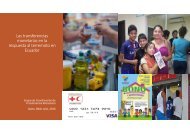Simatelele
2lF850q
2lF850q
Create successful ePaper yourself
Turn your PDF publications into a flip-book with our unique Google optimized e-Paper software.
3. CASE STUDY<br />
RESEARCH METHODS<br />
Field research took place in two wards of the Binga<br />
District (<strong>Simatelele</strong> and Siachilaba), with additional<br />
key informant interviews with Econet and SC staff<br />
in Harare. Save the Children identified both wards<br />
for household surveys and FGDs using purposive<br />
sampling, 22 and then randomly selected survey<br />
participants. Implementation of the survey and<br />
FGDs ran concurrently. Save the Children hired<br />
enumerators to administer the surveys in Tonga,<br />
the local language.<br />
Three hundred fifteen people responded to the<br />
survey (81% of whom were women). FGDs took<br />
place with 29 participants (52% of whom were<br />
women). KIIs took place with 10 representatives<br />
from Save the Children and four from EcoCash<br />
(see KII details in Appendix 1). The average<br />
age of all research participants was 44; survey<br />
households averaged five members.<br />
Zimbabwe – Save the Children<br />
Household surveys contained 46 research questions, categorized into the following topical sections:<br />
Demographics<br />
Experience using the e-transfer mechanism<br />
Mobile wallet usage<br />
Financial behavior before the Save the Children project (savings, credit, money transfer)<br />
Financial behavior after the project<br />
FGDs conducted by the consultant focused more narrowly on:<br />
Mobile phone ownership and mobile money knowledge and account usage – both before and after<br />
the project<br />
General savings and money transfer behavior<br />
RESEARCH LIMITATIONS<br />
This study was not intended as a large-scale, fully randomized survey. As such, it should be noted that<br />
without a purely random selection among all recipients, there may be some research bias towards<br />
respondents who are easier to reach or more articulate in answering questions. Focus group discussions<br />
22<br />
Purposive sampling, also referred to as judgment, selective or subjective sampling is a non-probability sampling method that is characterized by a deliberate effort to gain<br />
representative samples by including groups or typical areas in a sample.<br />
CAN E-TRANSFERS PROMOTE FINANCIAL INCLUSION IN EMERGENCIES: A CASE STUDY FROM ZIMBABWE 15



